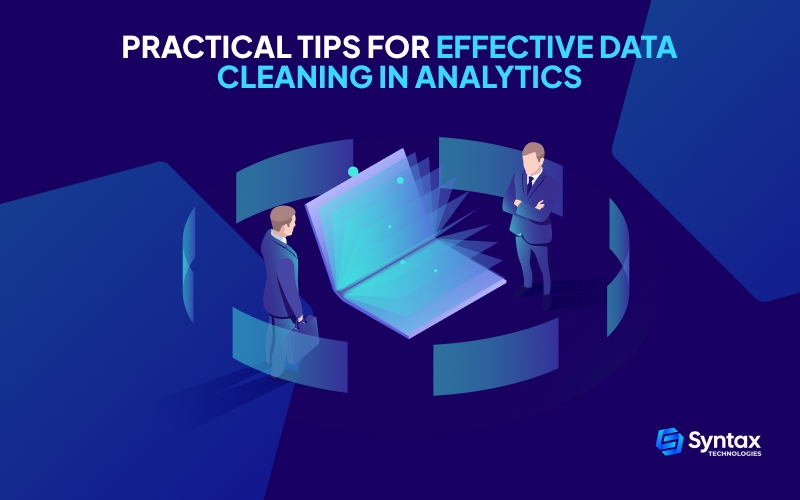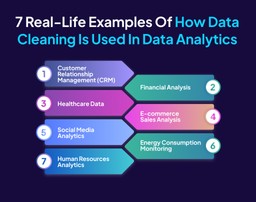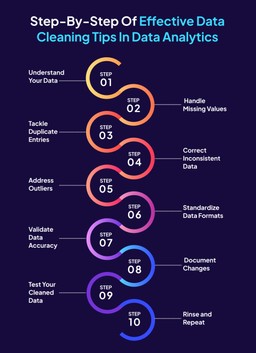Embarking on your data journey is like diving into a treasure trove of insights, but before you unearth the gems, there’s a crucial pitstop ? data cleaning.
Picture it as polishing your telescope before stargazing; it’s the key to crystal-clear analytics.
In this data-driven adventure, we’re here to equip you with the ultimate toolbox of practical tips for effective data cleaning.
And what better way to learn about the latest tools used in data cleaning than a data analytics course?
Committing to such a comprehensive program will elevate your understanding and prepare you to face the data wave quickly!
Now, are you ready to turn raw data chaos into precision?
Let’s dive into the exhilarating world of data cleaning!
What’s Data Cleaning?
In simpler terms, data cleaning (or data cleansing) is the meticulous process of identifying and correcting your datasets’ errors, inconsistencies, and inaccuracies.
It’s like fine-tuning the strings of an instrument before playing a symphony ? a crucial step to ensure that the insights drawn from your data are accurate and reliable.
Data cleaning is your trusted guide through the labyrinth of imperfections, from typos and missing values to quirky outliers and duplicate entries.
What Are Its Key Features?
Alright, let’s break down the cool features of the data cleaning process in a way that won’t make your brain do gymnastics!
1. Detective Skills
Data cleaning is like a digital detective. It spots spelling mistakes, missing puzzle pieces (we call them values), and even those sneaky twins ? duplicate entries.
2. Magic Eraser for Mistakes
Ever accidentally typed “teh” instead of “the” in a text? Data cleaning catches those little typos and cleans them up, making your data talk without stumbling over its words.
3. Missing Piece Finder
Imagine a jigsaw puzzle with a piece missing ? frustrating, right? Data cleaning hunts down those gaps, filling in the blanks so your dataset is complete and ready to impress.
4. Outlier Buster
Some data points are like wild party crashers ? they don’t fit in. Data cleaning helps identify and handle these outliers, ensuring your analysis isn’t thrown off by unexpected guests.
5. Clone Wars Defense
Duplicate entries are the clones of the data world. Data cleaning brings order to the chaos, wiping out those duplicates so you can trust your data gang isn’t getting too crowded.
6. Neat Freak Organizer
Data cleaning organizes your data closet, ensuring everything has its proper place and is ready to spark joy in your analytical adventures.
Data cleaning is your data’s superhero, armed with superpowers to tidy up, fix errors, and make your dataset shine.
What’s The Role of Data Cleaning in Data Analytics?
Did you know that 1.134 trillion MB of data is created every day?
As a data analyst, dealing with such data can be challenging without facing tons of errors during processing. That’s when data cleaning can be helpful, especially when data needs to be collected for analysis and comparisons.
So, let’s zoom in on the superhero role that data cleaning plays in the dazzling world of data analytics.
1. Reliable Insights Builder
Data analytics is all about uncovering insights and making informed decisions. Imagine constructing a skyscraper on shaky ground ? not cool, right? Data cleaning lays a solid foundation by removing errors and inconsistencies, ensuring the insights you draw are trustworthy.
2. Precision Maestro
Data cleaning fine-tunes your dataset like a musical maestro tuning an orchestra. It eliminates the noise ? the outliers and duplicates ? so your analysis hits the right notes. The result? A symphony of precision in your analytics performance.
3. Trend Spotter
Ever tried finding patterns in a messy room? Not easy! Data cleaning declutters your data, making it easier to spot trends and patterns. It’s like turning on the spotlight so that the important stuff shines through.
4. Decision Support Wingman
Picture data analytics as your co-pilot on a data-driven journey. Data cleaning ensures your wingman (your data) has a clear vision by ironing out any hiccups, making it a reliable companion for steering your decisions in the right direction.
5. Time Traveler’s Guide
Analyzing historical data is like flipping through an old photo album. Data cleaning ensures that the snapshots are clear and accurate, helping you learn from the past and make smarter choices for the future.
6. Resource Saver
Data analytics can be a hungry beast, devouring resources. Data cleaning is a wise steward, optimizing your dataset to ensure you’re not wasting time and computing power on unnecessary clutter. Focusing instead on data quality.
Some Examples of Data Cleaning Tools Used in Analytics
Let’s talk about some handy data tools that make data cleaning feel like a breeze ? because who wants to scrub data with a toothbrush, right?
OpenRefine: t lets you explore, clean, and transform your data with a user-friendly interface. Whether it’s spotting duplicate data, fixing text errors, or dealing with messy dates, OpenRefine has got your back.
Trifacta: Trifacta uses machine learning to understand your data and suggests cleaning transformations. It’s great for taming unruly datasets and turning them into well-behaved, analysis-ready tables.
DataWrangler (by Stanford): If you’re into user-friendly, point-and-click solutions, DataWrangler is your go-to buddy. It lets you visually explore your data and apply transformations without having to write a single line of code.
Excel (Yes, good ol’ Excel): Don’t underestimate the power of Excel in data cleaning. With its functions and features, you can wrangle data, spot errors, and clean things up.
Pandas (Python Library): If you’re comfortable with coding (or want to learn), Pandas is a Python library that’s widely used for data manipulation and cleaning. It’s like having a programming wand to cast spells on your dataset, transforming it into exactly what you need.
SQL (Structured Query Language): For those who speak the language of databases, SQL is a formidable ally. It helps you filter, sort, and clean data directly in databases, ensuring your queries return polished results.
Whether you’re a point-and-click adventurer or a coding wizard, there’s a tool ready to make your data sparkle.
7 Real-life Examples of How Data Cleaning is Used in Data Analytics
Here are seven real-life examples that highlight how data cleaning plays a crucial role in various data analytics scenarios:
Customer Relationship Management (CRM):
- Challenge: In CRM databases, customer information may be entered inconsistently, with variations in spelling, addresses, or contact details.
- Data Cleaning Solution: Standardizing and cleaning customer data ensures accurate customer profiles, enabling businesses to personalize interactions, analyze customer behavior, and enhance overall customer satisfaction.
Financial Analysis:
- Challenge: Financial datasets often have missing values or discrepancies due to human error or system glitches.
- Data Cleaning Solution: Rigorous data cleaning ensures the accuracy of financial reports. By handling missing values and correcting inconsistencies, financial analysts can make reliable predictions, assess risks, and support strategic decision-making.
Healthcare Data:
- Challenge: Patient records in healthcare databases may contain errors, duplicate entries, or missing information.
- Data Cleaning Solution: Cleaning healthcare data is critical for patient care and research. Accurate and consistent data allows healthcare professionals to identify trends, track patient outcomes, and conduct meaningful research for improved medical practices.
E-commerce Sales Analysis:
- Challenge: E-commerce databases often suffer from duplicate entries, incorrect product categorizations, or inconsistent pricing formats.
- Data Cleaning Solution: Cleaning the e-commerce dataset ensures accurate sales analysis. It helps in understanding customer buying behavior, optimizing pricing strategies, and maintaining a reliable inventory management system.
Social Media Analytics:
- Challenge: Social media data can be messy with variations in usernames, hashtags, or timestamp formats.
- Data Cleaning Solution: Standardizing and cleaning social media data allows marketers to track engagement, measure campaign success, and understand audience sentiments accurately. Consistent data is essential for effective social media analytics.
Energy Consumption Monitoring:
- Challenge: Energy consumption datasets may have outliers, missing data points, or inconsistencies due to measurement errors.
- Data Cleaning Solution: Cleaning energy consumption data ensures accurate analysis for energy efficiency initiatives. It helps identify anomalies, optimize resource allocation, and implement effective strategies for sustainable energy use.
Human Resources Analytics:
- Challenge: HR databases may contain outdated employee records, inconsistent job titles, or missing performance metrics.
- Data Cleaning Solution: Cleaning HR data ensures accurate workforce analysis. It helps in talent management, succession planning, and creating fair compensation structures based on reliable and up-to-date employee information.
In each of these examples, data cleaning is not just a preliminary step but an ongoing process essential for deriving meaningful insights and making informed decisions in various domains.
Step-by-Step of Effective Data Cleaning Tips in Data Analytics
Let’s break down the process of effective data-cleaning techniques into a simple step-by-step guide.
Get ready to wear your data detective hat and dive in!
Step 1: Understand Your Data
Before you start cleaning, get to know your data like an old friend. Understand its structure, variables, and overall patterns. This helps you identify potential issues more effectively.
Step 2: Handle Missing Values
- Identify Missing Values: Use tools or functions to identify missing quality data.
- Decide How to Fill or Handle Them: Depending on your data and context, you can either fill missing values with averages, drop rows with missing values, or use more advanced imputation techniques.
Step 3: Tackle Duplicate Entries
- Identify Duplicates: Look for identical rows or entries using tools or functions.
- Remove or Consolidate Duplicates: Decide whether to delete irrelevant data or duplicates or consolidate them, depending on your analysis goals.
Step 4: Correct Inconsistent Data
- Spot Inconsistencies: Identify variations in spelling, capitalization, or format.
- Standardize and Clean: Use tools to standardize text, correct typos, and ensure consistent formatting.
Step 5: Address Outliers
- Identify Outliers: Use visualizations or statistical methods to spot data points significantly different from the majority.
- Decide How to Handle Them: Depending on your analysis goals, you can either remove, transform, or adjust outlier values.
Step 6: Standardize Data Formats
- Dates and Times: Ensure consistency in date and time formats.
- Numeric Formats: Standardize units and formats for numerical data.
Step 7: Validate Data Accuracy
- Cross-Check Data: Verify data against reliable sources or conduct cross-checks to ensure accuracy.
- Correct Errors: Address any inaccuracies found during validation.
Step 8: Document Changes
- Keep a Log: Maintain a record of all the changes made during the cleaning process.
- Document Assumptions: Note any assumptions or decisions made during cleaning for transparency.
Step 9: Test Your Cleaned Data
- Run Tests: Perform tests or spot-checks to ensure the data behaves as expected.
- Iterate if Necessary: If issues are found, go back and refine your cleaning process.
Step 10: Rinse and Repeat
- Iterate as Needed: Data cleaning is often an iterative process. As you analyze your data, you might discover new issues or realize the need for further refinement. Don’t hesitate to repeat steps if necessary.
Remember, effective data cleaning is both an art and a science.
It’s about striking a balance between thoroughness and practicality to ensure your data is not just clean but also ready to deliver meaningful insights.
Unveiling the Power of Data Cleaning with Syntax Technologies
Effective data cleaning can guide us toward accurate analyses, informed decisions, and a profound understanding of the stories hidden within the numbers.
At Syntax Technologies, we understand the significance of mastering data analytics and its tools.
Whether you’re new to data or want to improve your skills, our courses cover everything from data cleaning to analysis.
They’re designed to give you both knowledge and practical experience to handle data challenges.
With our friendly and engaging approach, you’ll gain insights into the world of data and discover the confidence to wield data analytics like a pro!





